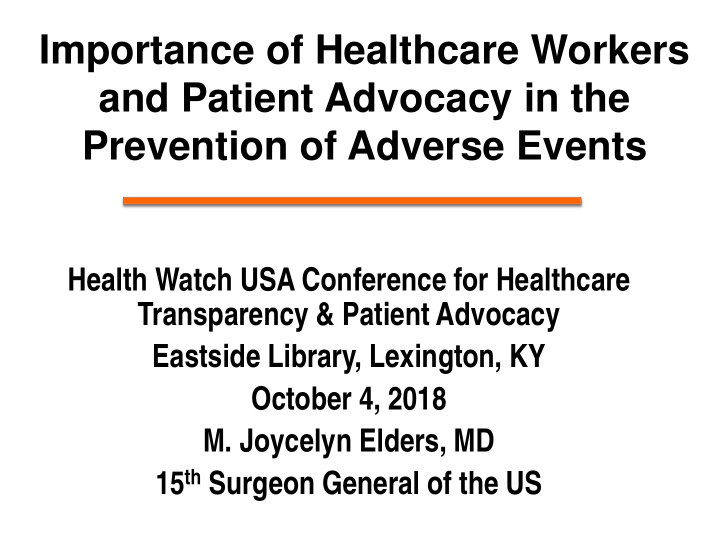



Importance of Healthcare Workers and Patient Advocacy in the Prevention of Adverse Events Health Watch USA Conference for Healthcare Transparency & Patient Advocacy Eastside Library, Lexington, KY October 4, 2018 M. Joycelyn Elders, MD 15 th Surgeon General of the US
Patient Advocate • Patient advocacy is an area of specialization in health care concerned with advocacy for patients, survivors, and caregivers. • The patient advocate may be an individual or an organization. • The terms patient advocate and patient advocacy can refer both to individual advocates providing services that organizations also provide, and to organizations whose functions extend to individual patients.
Major Tenets of Advocacy • Preserving human dignity • Patient equality • Freedom from suffering
Patient Advocacy in Nursing • Protection from harm, promotion, optimization of health and abilities. • Prevention of illness and injury • Alleviation from suffering through diagnosis and treatment • Advocacy and care of individuals, families, communities, and populations.
Keys to Advocacy and Safety • Collaboration • Cooperation • Transparency • Consistency
Role of Nursing • The most important role of nurses is to deliver quality care including: – Knowledge about diseases – Patient advocates – Help patients make informed decisions regarding their health, including: • Navigating a complex medical system • Translating medical terms • Making ethical decisions
Personal Attributes of Effective Nurse Advocates • Professional competence • Objectivity • Flexibility • Empathy • Self-motivation • Accountability • Commitment to patient, profession & institution • Sense of responsibility • Strong coping skills
Transparency In order to be transparent, we must: • Have early learning • Steal good ideas and share them • Work as partners • Mentor • All be teachers • All be learners
10 Recommendations on How to Increase Transparency, Improve Patient Safety Patient advocates should be included on every board. 1. Leaders and boards of health organizations should link hiring, firing, promotion, and compensation of leaders to results in cultural transformation and transparency. 2. Being transparent regarding the membership of the board is also vital for leaders. 3. Major healthcare organizations like the Agency for Healthcare Research and Quality, the National Quality Forum, CMS and accreditation bodies should ensure data sources — such as claims data, patient registry data, clinical data and patient- reported outcomes — are accessible to patients and the public. Continued
4. Executives and clinicians should provide patients with descriptions of alternatives for tests and treatments, as well as the pros and cons for each. 5. Executives and clinicians should also provide patients with information about their planned tests and treatments using terminology they can understand. 6. Providing both patients and clinicians with organized support when they are involved in accidents is also important for executives. 7. Clinicians should create processes to address threats to accountability such as disruptive behavior, substandard performance, violation of safe practices and inadequate oversight of colleagues' performance.
8. Among organizations, executives and boards should establish mechanisms to adopt best safety practices from one another and participate in collaboratives to accelerate improvement. 9. To improve transparency with the public, regulators and payers should ensure all healthcare entities have core competencies to accurately and understandably communicate their performance. 10. Regulators and payers should also be sure healthcare organizations publicly display the measures they use for monitoring quality and safety via dashboards, organizational report cards or some other tool. The National Patient Safety Foundation's Lucian Leape Institute has issued numerous recommendations to improve transparency after holding two roundtable discussions on the topic as it relates to patient safety.
Patient Safety The aim is to increase patient safety in American hospitals, and to get to “0” harm. To prevent harm and to have a safety culture, we must have: • Culture of open reporting • Just culture • Learning culture • Informed culture
Safety Behaviors • Have early prevention training. • High reliability • Accept human errors & medical errors. • Respond quickly. • Timely • Standardized • Quick response • Be optimistic. • Focus on safety.
Importance of Patient Advocacy by Healthcare Workers • A – Awareness • D – Dedication to higher quality patient care • V – Voice, Vision • O – Objectivity, Opportunity • C – Communication, Competence Commitment • A – Action plan, Advocacy, Accountability • C - Cooperation, Collaboration • Y – You, everyone is involved.
• The End
Recommend
More recommend